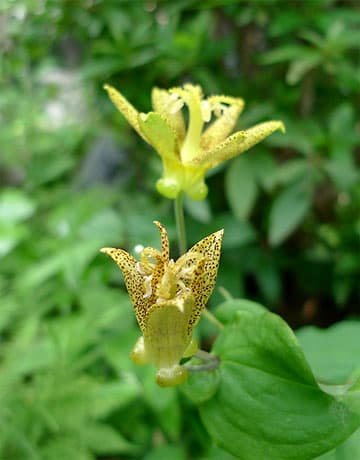Perennial from the Convallariaceae family.
Flower color: golden yellow with brown spots.
Flowering plant height: 50 cm.
Natural flowering period: June - July.
Winter hardiness zones: Z4 - Z8. Winter-hardy without shelter.
Name: Ancient Greek, meaning "three tubercles" (triple nectary).
Description: all species of the genus are extremely ornamental herbaceous plants. They grow in Japan and the Himalayas. There are 10 species in the genus.
In nature, it is found in the shady forests of Japan and China. The leaves are ovate, green, with dark spots that appear more strongly at the beginning of growth.
It blooms in mid-summer before other tricyrtis.
Location: Tricyrtis prefer rich and loose forest soils in partial shade. Moisture-loving, but drought-resistant.
Reproduction: when growing from seeds, it is desirable to sow in open ground immediately after harvest or post-sowing cold stratification within one to two months. 1,0 g = 1650 seeds.
They bloom in the first or second year after sowing. Vegetatively can also be propagated by division and cuttings (basal - in spring, stem - in summer).
Use: all tricyrtis are showy and rare plants in cultivation. Very good for group planting in forest-type rockeries: "ravine" and "bog". The flowers, which are star-shaped and spotted, are often used to decorate bouquets.
Partners: perfectly harmonize with Arisaema, Orchids, Ferns, Trilliums and Hostas.

Toad Lily, Troad Lily. Bot. syn.: Tricyrtis bakeri.
"Princess Frog".
Few people know about this flower, but they are in no hurry to get to know him closely ...
The name scares away: the people call it "toad lily". And scientifically, by the way, he is tricyrtis. If translated from Greek, it turns out "triple nectary."
That is why, even without being literate, the bees flock together to his generous treat.
By the way... tricyrtis blooms continuously throughout July and August and gets along well in shady corners of the garden next to ferns, hostas, garden orchids, arizema and trillium.
It turned out that tricyrtis was called the toad lily because its smell attracts all types of frogs, including edible ones. The hunters knew about this and before hunting they rubbed the body and hands with the leaves of the plant, in addition, the thickened juice of tricirtis became sticky, which made it easier to catch the French delicacy.
In nature, this lily grows on loose forest soils in partial shade, loves moisture, but does not suffer too much from drought. Guided by this, you can plant it in a prepared place by adding peat and leaf humus to the hole.
Blooming tricyrtis is very fond of bees - they swarm over it. It grows beautifully near a pond: frogs really love it very much ...















